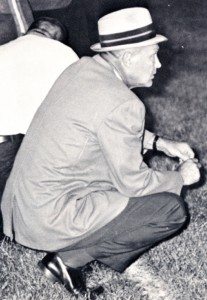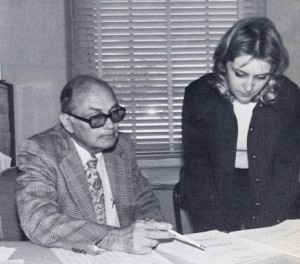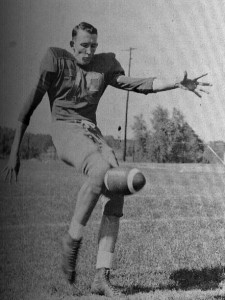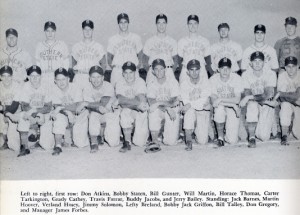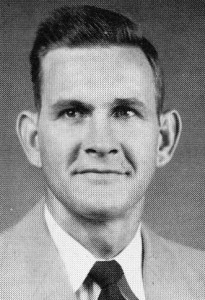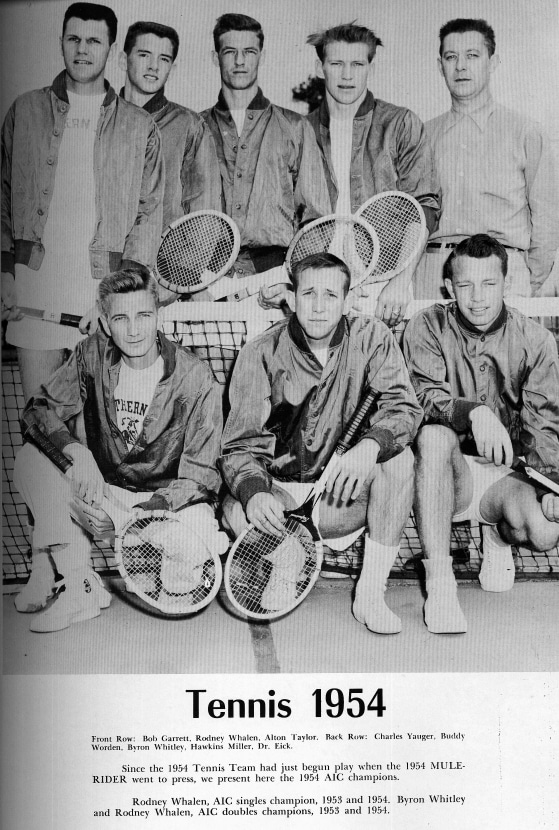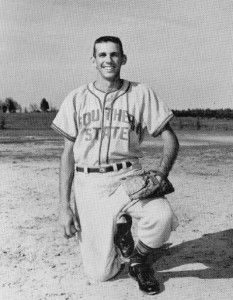(Excerpted from James F. Willis, Southern Arkansas University: The Mulerider School’s Centennial History, 1909-2009, pp. 226-229)
As early as December 1953, Dr. Camp had felt it necessary to seek support from the board of trustees against “attacks by over-enthusiastic football fans.” Their unhappiness could only have increased afterward as the football program did not repeat the triumphs of 1951–52 during the rest of the decade. Dr. Camp may have lost some support when in 1952 he told Kathryn Brown to end women’s basketball because it was not “lady-like.” But his larger problem was controversy over football conference rules. Camp tried to explain athletic policies in more than half the articles of a special eighteen-part series he wrote about SSC in 1954 for the Magnolia Banner News. The Arkansas Intercollegiate Conference (AIC), like other conferences across the country in the 1940s and early 1950s, still wrestled with the question how to maintain college sports’ amateur status, a problem that had worried A&M President Overstreet in the 1930s. The AIC college presidents voted in December 1952 to adopt a strict rule prohibiting scholarships or subsidies to players. It would be fully implemented in 1954 when current players had exhausted their eligibility. Immediately there were to be no more scholarships to athletes beyond those available to any students. This policy did not please Magnolia boosters and apparently was not strictly enforced.
Subsequently in December 1955, the presidents of four AIC colleges—Arkansas A&M at Monticello, Arkansas State Teachers College, Henderson, and Ouachita—decided their teams would no longer play SSC’s Muleriders or Arkansas Tech’s Wonder Boys due to rules violations. The decision effectively excluded the two schools from the conference but without specific charges. Orville Henry of the Arkansas Gazette, the dean of Arkansas sportswriters, denounced the failure to offer proof as “just as unsportsmanlike and indefensible as the supposed violations.” Sportswriters apparently believed that almost all AIC schools bent the strict rules. However, until 1959 when a “compromise” in the AIC restored scholarships and SSC and Tech to the conference, SSC had little choice but to play stronger out-of-state schools with only an occasional Arkansas opponent. Long trips on the school bus—an old green U.S. Army surplus vehicle—that players said rode like it had “square wheels,” even in the capable hands of drivers like Earl Long and Earl Miller, were exhausting. Once these out-of-state games began, it was clear that Louisiana and Oklahoma teams were a “notch above” the usual AIC competition.
As a result, SSC players and fans had to endure three seasons of defeats, 1956 through 1958, during which the Muleriders won only eight games out of twenty-nine. Magnolia supporters rallied around the team and turned a previously informal group into an official boosters club on August 23, 1956, with C. R. “Bob” Cole, a McAlester executive, as its first president. Coach Auburn Smith had become head coach and had to deal with these lean years. Coach Elmer Smith left in 1954 to join Bear Bryant at Texas A&M. Coach Auburn had a winning team in 1954, almost equaling the best years of Coach Elmer and was named AIC Coach of the Year. Larry McNeal, who played for Coach Auburn in those years, said the team could have been more successful had there been more talented reserves. But the good-hearted coach sometimes gave scholarships to weaker second-or third-team players who could not otherwise have afforded to attend SSC. Coach Auburn could be a tough coach and demanded much of his players on the field. But he told the young men at the beginning of each season that they needed to have their priorities straight. First came the students’ religion, family, and studies and only then football. It was the way Coach Auburn lived his life and what he tried to pass on. When he ceased coaching and served as athletic director, he also took the school’s job as director of financial aid and worked to help poor students attend school. Sometimes, he anonymously gave his own funds to worthy students if the need arose.
In those dark years, 1956–58, the Mulerider football team had many good players including one of the best quarterbacks ever to play at the school, Calvin Neal, who was twice picked for NAIA all-American teams. When SSC resumed AIC competition in 1959, Neal led the team to a winning 6–3 season, and seven of his teammates made all-AIC teams. But Coach Auburn’s teams never repeated the glory days of the early 1950s.
The Mulerider drought in football was offset to some extent by the performance of SSC’s basketball teams. Arkansas Tech dominated AIC basketball for almost two decades after the Second World War. Even the great play of the sharpshooter William “W. T.” Watson and the hook shot artistry of Calvin “Cotton” Thomas in 1951–53 could not break Arkansas Tech’s grip on the AIC title. When Prentice “Duddy” Waller returned to his alma mater in 1955 to assist in football and head the basketball program, he built a team that ended Tech’s ascendancy. His teams, noted for hustle and defense, were among the finest in school history and had outstanding players such as Jimmy Culp, Lester Hutchinson, Calvin Neal, Steve Sheiron, Jim Solomon, and Bobby “Cotton” Staten. In 1957 before a “houseful of rabid fans” from Magnolia, Waller’s team downed Tech 74–68 to win the NAIA (National Association of Intercollegiate Athletics) tournament in Pine Bluff. It was the first time in school history a Mulerider team had won an NAIA District 17 Championship. When Waller left to coach at the University of Arkansas, Delwin Ross took over. His 1959 team with its “terrific one-two punch” of Steve Sheiron and Frank Dolan also advanced to the NAIA District 17 finals but lost to Arkansas State Teachers College (ASTC) and its star player Monroe Ingram. School spirit for basketball in those years was said to be the “best” in a long time. That support was shown by the “spirit stunt” of seven SSC men who in three days walked the 108 miles to the Pine Bluff game, leading Optimaggie and Adolphus all the way.
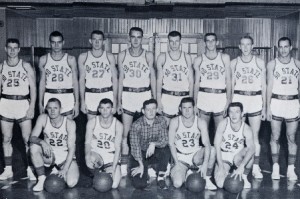
1957 Basketball Team. Front row, l. to r.: Jimmy Culp, Lynwood Cathey, Manager John Clary, J. W. Evers, Norris Fox. Back row: James Simmons, Steve Sheiron, Calvin Neal, George Kirtley, Frank Dolan, Jimmy Solomon, Douglas Dildy. Not pictured: Phil Arman, Bobby Kirtley, Bobby Staten (Click photo to enlarge)
Other sports won championships including baseball, tennis, and golf. Sam Bailey returned to his alma mater, like Ross and Waller, to assist in football and head a second sport. Bailey’s charge was baseball from 1950 to 1956. His 1953 team tied for the AIC title. Subsequently, behind the outstanding pitching of Travis Farrar and Jim Solomon, the power hitting of Wesley “Buddy” Jacobs, and the solid catching of Grady Cathey, the team would win the AIC outright in both 1954 and 1956. Jim Solomon was perhaps the first Mulerider ever to receive a professional sports contract, pitching for a time in the St. Louis Cardinals baseball’s minor league system. The tennis team led by singles champion Rodney Whalen took AIC titles in 1954 and 1954, and the golf team led by the skilled play of Conrad Knauts won an AIC championship in 1954.

